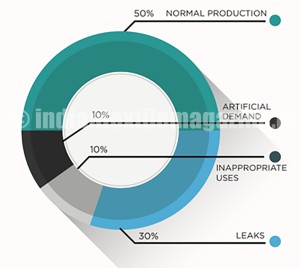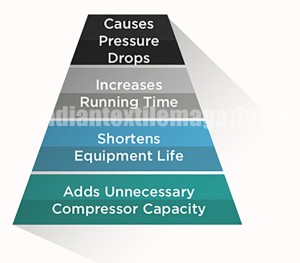By Mr. Hidhay. K, Managing Director – Asia Pacific, Systel Energy Solutions (India) Pvt. Ltd.
Leaks are a significant source of wasted energy. There are two types of air leaks – planned and unplanned. The planned leaks are the ones that have been designed into the system. These leaks are blowing, drying, sparging, etc., used in the production process. Many times these have been installed as a quick fix for a production problem.
The unplanned leaks are the ongoing maintenance issues and can appear in any part of the system. These Leaks require an ongoing air leak detection and repair program. While leakage can come from any part of the system, the most common problem areas are:
* Couplings, hoses, tubes and fittings. Tubes and one-touch fittings are common problems.
* Disconnects. O-Rings required to complete the seal may be missing.
* Filters, regulators and lubricators (FRLs). Low first cost improperly installed FRLs often leak.
* Open condensate traps. Improperly operating solenoids and dirty seals are often problem areas.
* Pipe joints. Missed welds are a common problem.
* Control and shut-off valves. Worn packing through the stem can cause leaks.
* Point of use devices. Old or poorly maintained tools can have internal leaks.
* Flanges, missed welds are a common problem.
* Cylinder rod packing, worn packing materials can cause leaks.
* Thread sealants. Incorrect and/or improperly applied thread sealants cause leaks. Use the highest quality materials and apply them as per the instructions.
Estimating amount of leakage:
For compressors that have start/stop controls, there is an easy way to estimate the amount of leakage in the system. This method involves starting the compressor when there are no demands on the system (when all the air operated end use equipment is turned off).
A number of measurements are taken to determine the average time it takes to load and unload the compressor. The compressor will load and unload because the air leaks will cause it to cycle on and off as the pressure drops from air escaping through the leaks. Total leakage (percentage) can be calculated as follows:
Leakage % = [(T x 100)/(T+t)]
where: T = on-load time (minutes) and
t = off-load time (minutes)
Leakage will be expressed in terms of the percentage of compressor capacity lost. The percentage lost to leakage should be less than five per cent in a well-maintained system. Poorly maintained systems can have losses as high as 20-30 per cent of air capacity and power.
Leak detection
EUS-based LeaksPro ultrasonic leak detection is probably the most versatile form of leak detection. Due to its capabilities, it is readily adapted to a variety of leak detection situations. LeaksPro EUS leak detectors are generally unaffected by background noises and hence can be used in very noisy production floors to focus only on compressed air leaks. LeaksPro EUS leak detectors can find small to large-sized leaks. The advantages of LeaksPro EUS leak detectors include versatility, speed, ease of use and the ability to detect leakages without the need to stop the machine. The operator requires minimum training and becomes an expert in leak detection within 15 minutes of training. Hence LeaksPro leak detectors are not only fast, but it is also are very accurate.
How to fix leaks
Leaks occur most often at joints and connections. Stopping leaks can be as simple as tightening a connection or as complex as replacing the faulty equipment such as couplings, fittings, pipe sections, hoses, joints, drains and traps. In many cases leaks are caused by bad or improperly applied thread sealant. Select high quality fittings, disconnects, hose, tubing and install them properly with appropriate thread sealant.
Non-operating equipment can be an additional source of leaks. Equipment no longer in use should be isolated with a valve in the distribution system.
Another way to reduce leaks is to lower the demand of air pressure in the system. The lower the pressure differential across an orifice or leak, the lower the rate of flow. So reduced system pressure will result in reduced leakage rates. Stabilizing the system header pressure at its lowest practical range will minimise the leakage rate for the system. Once leaks have been repaired the compressor control system should be re-evaluated to realise the total savings potential.
Establishing a leak prevention program
There are two basic types of leak repair programs – the leak tag program and the seek and repair program. The seek and repair is the simplest. Here, you simply find the leak and repair it immediately. With the leak tag program, the leak is identified with a tag and documented for repair at a later time. This kind of documented leak repair programs is the best as they indicate the root causes of leakages, and where leaks occur frequently and which component fails fast. Once proper corrective steps are initiated these kind of leaks do not reoccur in the system.
The best approach is to use mobile-based softwares as they document extensive information and produce various analytical reports.
There are several key elements required to have a successful leak repair program, which are discussed below:
* Baseline compressed air usage
* Assess the leak loss
* Develop the cost of air leaks
* Identify leaks
* Document the leaks
* Prioritise leak repair
* Document repairs
* Compare baselines and publish results
* Start all over again
A good compressed air system leak repair program is very vital for maintaining the efficiency, reliability, stability and cost-effectiveness of any compressed air system.
LeaksPro Professional Leakage Management Solutions offer a combination of the best-in-class leakage detectors with the Laser Guidance System and a mobile-based software package for very extensive documentation. The cloud-based Analytical Reporting Tools offer information on the nature and cause of leaks and the repair that needs to be carried out while also assisting the users to develop a systematic and sustainable leakage management program.

